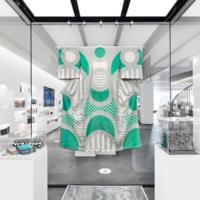Shoppers can find blue labels on some products at a shop in Tokyo Midtown telling them the package contains marine products caught with attention paid to sustaining marine resources and protecting the ecosystem.</PARAGRAPH>
<PHOTO>
<TABLE WIDTH='250' ALIGN='RIGHT' BORDER='0'>
<TR>
<TD><IMG ALT='News photo' BORDER='0' SRC='../images/photos2007/nn20070524f2a.jpg' WIDTH='250' HEIGHT='184'/></TD>
</TR>
<TR>
<TD><FONT SIZE='1'><B>A shopper picks out a package of fish bearing a label from the Marine Stewardship Council at Precce
Premium store in Tokyo's Roppongi district last month. The label is aimed at raising awareness of the
need to protect global fisheries resources.
</B> KYODO PHOTO</FONT></TD>
</TR>
<TABLE>
</PHOTO>
<PARAGRAPH>The sticker, unfamiliar to many consumers, is on packs of king salmon and 'gindara' sablefish at the Precce Premium store.</PARAGRAPH>
<PARAGRAPH>Other stores selling fish with the new label include Kamewa Shouten Co. of Tokyo, the first Japanese shop to start using the label created by London-based Marine Stewardship Council, and stores run by Aeon Co. and Seiyu Ltd.</PARAGRAPH>
<PARAGRAPH>The label includes the logo of the MSC, which is involved in the conservation of marine environments and protection of marine resources.</PARAGRAPH>
<PARAGRAPH>The aim of the label is to let consumers know at a glance that a marine product has been caught with consideration to the protection of fisheries products and the ecosystem. Arata Izawa of the World Wide Fund for Nature Japan said about 500 fish products with the label have been shipped around the world. People's awareness of the program here, however, is still low.</PARAGRAPH>
<PARAGRAPH>The MSC drew up conditions under which the label can be used that include such factors as the size of mesh in fishing nets and whether there a supervisory system in place to ensure fishermen are following the rules. </PARAGRAPH>
<PARAGRAPH>In addition to individuals and companies that fish, it allows processors and distributors to use the logo if they meet the organization's criteria.</PARAGRAPH>
<PARAGRAPH>Daishiro Seita, the promotions manager at Precce Premium, run by Tokyu Department Store Co., said it was the quality of the seafood bearing the label that made it a good buy.</PARAGRAPH>
<PARAGRAPH>'The fish is natural and has a good flavor,' Seita said. 'It doesn't smell like –
fish."
People in the fisheries and distribution industries are concerned seafood prices may rise if products bearing the label become popular here, because those products are more expensive than regular fish. For example, the price of salmon grown naturally in Alaska is one and a half to two times higher than farm-raised salmon from South America.
"Japanese people take it for granted that fish is cheap," said Kazuhiko Wada, president of Kamewa Shouten.
Japan has been making up for falling levels of marine resources in coastal waters with farm-raised and imported fish.

















With your current subscription plan you can comment on stories. However, before writing your first comment, please create a display name in the Profile section of your subscriber account page.